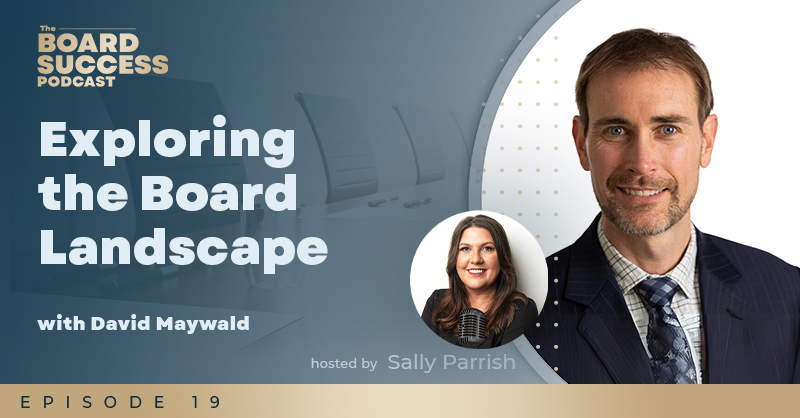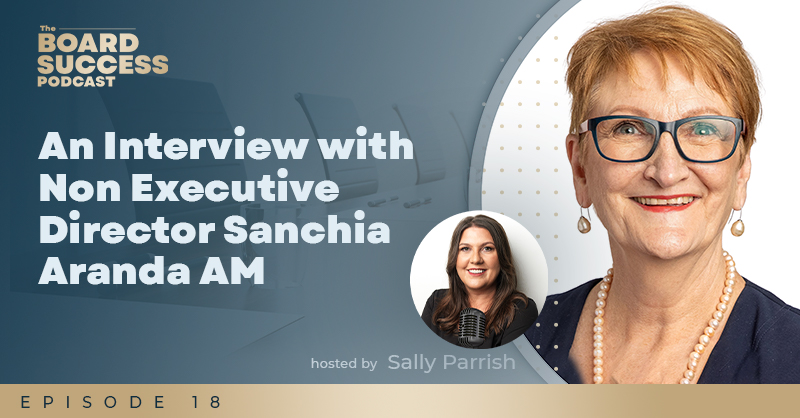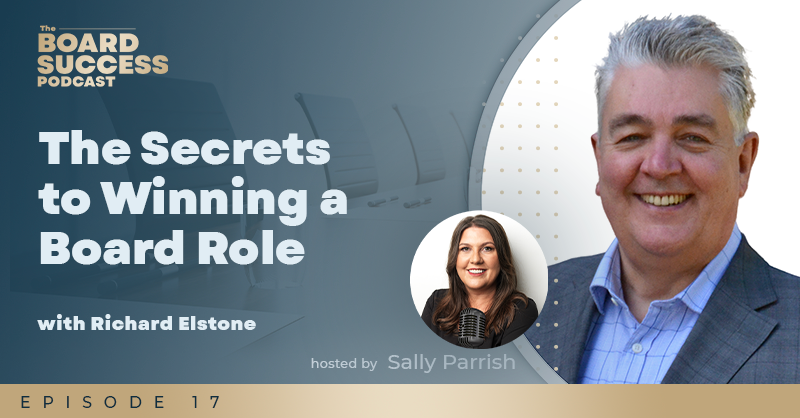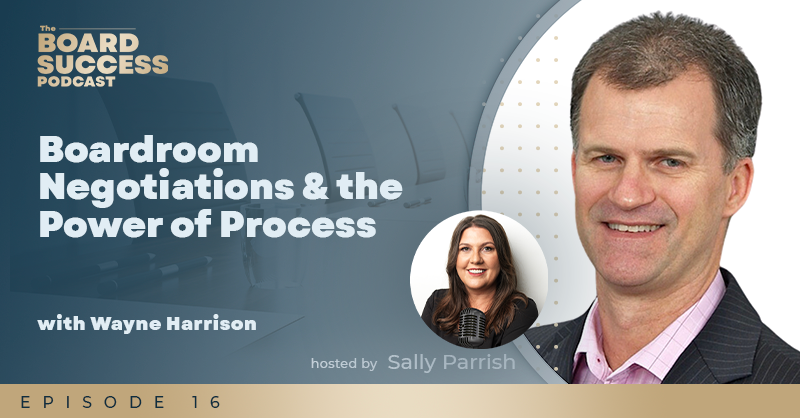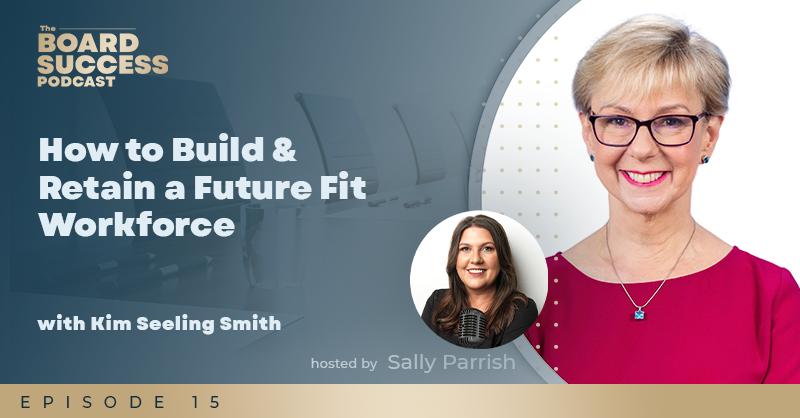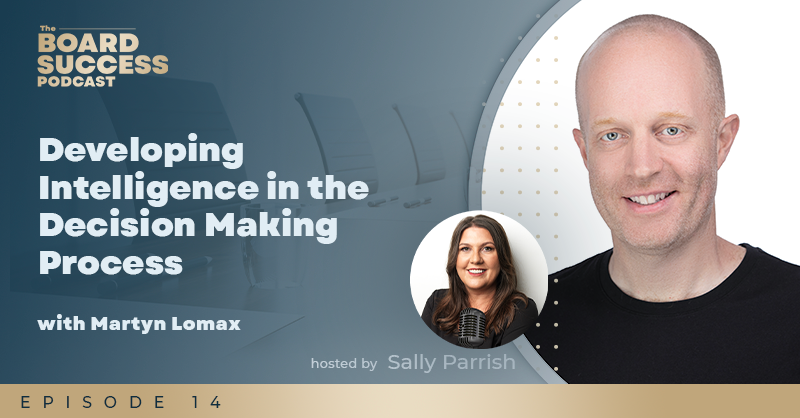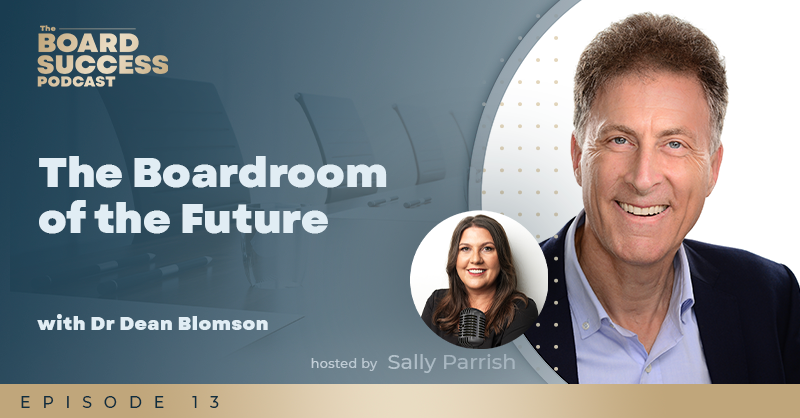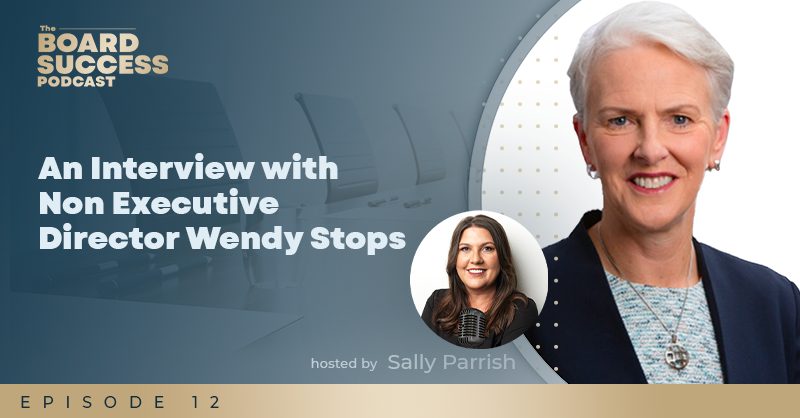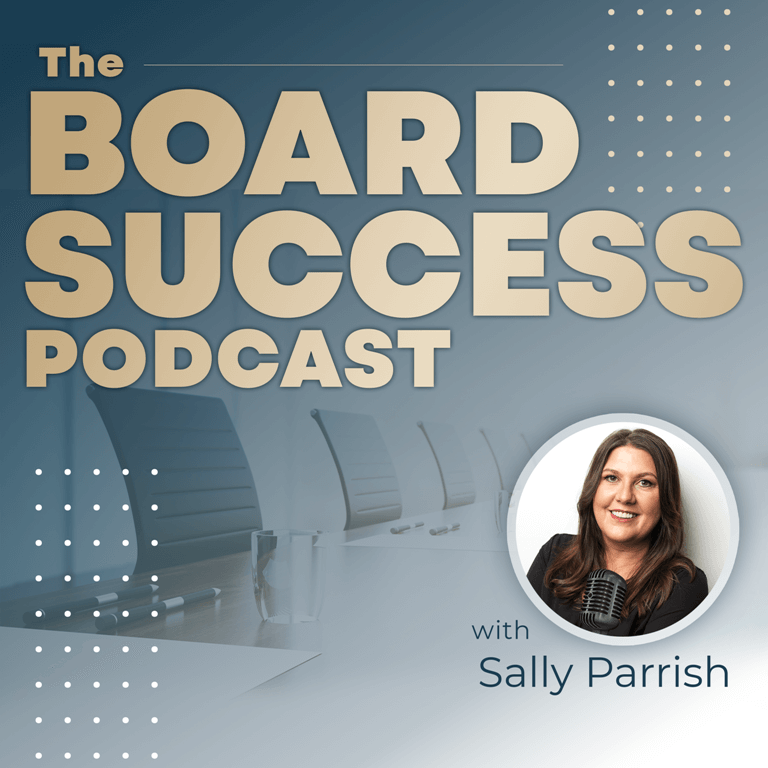An Interview with Anneli Blundell
Sally Parrish interviews Executive Coach Anneli Blundell
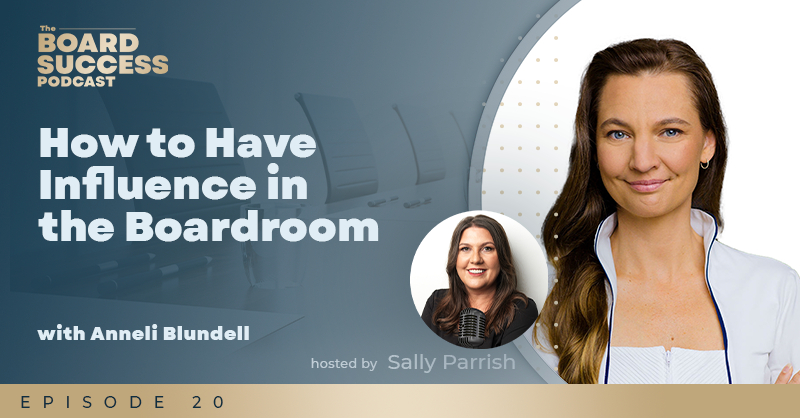
Back by popular demand, Anneli Blundell the People Whisperer joins us again for the podcast and shares her thoughts on how to have influence in the boardroom. She explains that we are always influencing people around us, although sometimes not always in a good way!
Anneli also takes us through tips on how to influence with integrity and flex your influencing approach to make a better impact and bring others along while avoiding some common mistakes board members often make.
As AITD’s L&D professional of the year and Gold Stevie Award winner for Female Entrepreneur of the year, 2021, Anneli’s passion for decoding people and performance dynamics make her a sought-after speaker, mentor and leadership expert. She makes the complex job of understanding why people do what they do (and how to get the best out of them), both accessible and entertaining.
Anneli works with leaders to increase their influence, engagement communication impact. She is the co-author of Developing Direct Reports: Taking the guesswork out of leading leaders, a reference guide for developing leadership performance on the job. She is also the author of several books on gender equity (including The Gender Penalty: Turning obstacles into opportunities for women at work and the pocketbook: When Men Lead Women: Navigating the facts, fears and frustrations of gender equality as a male leader) and was a featured guest expert on the documentary series, ‘Transcending the gender narrative’. She has served as the current President of the Vic/Tas chapter of PSA (Professional Speakers Australia) for 2 years. Her clients include Mercedes-Benz, Ernst and Young, Telstra, Victoria Police, NAB, JB HiFi, The Good Guys, BUPA and many more.
FURTHER INFORMATION
Meet Anneli on Linkedin https://au.linkedin.com/in/anneliblundell
Meet Anneli on X (Twitter) @AnneliBlundell
Clever but Clueless: Download your copy of the 'Clever but Clueless' resource mentioned in the podcast. Click here https://anneliblundell.com/clever-but-clueless-resources
Check out other Resources from Anneli Blundell including details on how to purchase her books 'The Gender Penalty' and 'When Men Lead Women'. Click here to visit www.anneliblundell.com
Click Here to View the Podcast Interview Transcript with Anneli Blundell
Anneli Blundell 00:00
There’s a couple of key reasons that I see influence really aiding people's ability to be effective in group scenarios and leadership teams and certainly on boards. The ability to make fast decisions. So if you think about what your role is on a board, it's to make really big decisions, important strategic decisions that affect the long term health of your organisation, often with minimal information, often with ambiguous information or incomplete information. So often, our role is really to come to a decision and lobby for that decision.
Sally Parrish 01:44
Today, we're rejoined by Anneli Blundell. Anneli was on one of the very first episodes of The Board Success podcast back in May or June 2023. And back by popular demand, I have to say we had so many great comments and such great feedback when she appeared earlier on in the series. Anneli is really one of my go to experts when it comes to influence and impact, topics that have very dear to my heart, all around influence and impact in the boardroom.
For those of you that didn't catch the earlier episode, Anneli Blundell, award winning expert in communication and human behaviour, an advocate for equity and a jigsaw puzzle extraordinaire. Anneli has been working as an executive coach for a lot of years, and has an incredible body of work that includes five publications. She came last time to discuss her most recent book, The Gender Penalty.
Today, we're speaking more broadly about influence and how to have influence in the boardroom. So welcome, Anneli. Thank you so much for coming back on.
Anneli Blundell 02:52
Thank you, Sally, always a pleasure to be with you.
Sally Parrish 02:56
Now they were raving last time you're on, there's so much depth to your body of work. And I have to congratulate you on that.
I'm going to have a rant here because I think the thing that you and I work on is so needed, so absolutely demanded, is what they call soft skills. Now why do they call it soft skills? I do not know because it kind of implies that it's something that's really easy to do or doesn't have much impact. But that whole soft skills, I think when it comes to Boardroom training, we spend so much time talking about governance and risk management and financial management, and all the theory in the world is not going to make you an influential leader. So I'm really glad that you're joining us to talk about this today.
What do you feel is the role that influence plays in boards? Why is influence important?
Anneli Blundell 03:57
There's a couple of key reasons that I see influence, really aiding people's ability to be effective in group scenarios and leadership teams and certainly on boards. The ability to make fast decisions. So if you think about what your role is on a board, it's to make really big decisions, important strategic decisions that affect the long term health and longevity of your organisation, often with minimal information, often with ambiguous information or incomplete information. So often, our role is really to come to a decision and lobby for that decision. And the idea is to have a group of very experienced very clever people around a room asking good questions, debating very clear concepts and coming to some sort of consensus.
So you're going to have people from different backgrounds. That means the topic of the day may be in your sweet spot, or it may not be in your sweet spot. And chances are, one topic out of 10 will land on your lap, in your area of expertise, but the rest won't be. And you're required to have a perspective, have an opinion, but also make a decision on that.
So we have to really rely on not just the information presented, but how influential we are when the information or the topic is in our sweet spot. And we have very strong opinions around that. We want to be able to bring people with us on that journey. And of course, even if it's just something that's not necessarily in your area of expertise, we also want to be able to have an input that has an impact, and is accepted for the well reasoned position that you're coming from.
Sally Parrish 05:53
I love that. Obviously not always gonna get accepted well. Any view or opinion that you have, have an influence, doesn't mean that you charm everybody into seeing your way and you agree, you know, like a Stepford wife, you start nodding Oh, yes. Okay, we'll do that. It's not about brainwashing, right, because we were expecting some resistance as part of this.
Anneli Blundell 06:17
Yeah, we are absolutely expecting resistance. And this is part of the influence piece that people don't understand.
I often talk about the key to your advanced influence is decoding the resistance to your influence. So you might sign up to an influencing skills course and they'll say, here are the three steps to influence and you go great, and you try those three things, and they don't work. And you go, why?
I'm following the bouncy ball, like literally couldn't be more simple, but it's not working in this context, with this person, with this message. And your key to advanced influence is to say, how do I decode the nature of this resistance? And when you become aware of that you're able to be more flexible around that. So you know what influence strategy to use, with what person, on what topic at what point in time?
Sally Parrish 07:15
So in leadership, we're talking about situational leadership, right? Who am I helping? And what's the scenario? What are their skills? Where are they at? And so you're talking about situational leadership there, understanding that there's going to be resistance that's contextual. It's based on what you're doing, and being able to navigate that as part of that piece as well.
Talk to me about your work around wrestling with ideas, because it's not always, the first idea is the best idea, right?
Anneli Blundell 07:48
Yeah, that's right. When we're talking about the usefulness or the utility of our influence skills, we need to be thinking about what we are talking about. As we talked about before, these are big ideas, these are important ideas, these are decisions. And we don't often have a lot of information around what we're having to decide upon.
So when we're in the middle of these conversations, it's not just about the big ideas. It's also the big egos, the big personalities, the big styles, the conversational influencing strategies that people tend to use. So we have to be able to navigate, how do we engage with these ideas and separate them from people's personal agendas, people's political agendas? Do people want to influence me to support this idea because this particular director needs to get a run on the board. And they feel like their time is up if they don't lobby for something and sort of get known for something. So it's politically really important to them. But is it really good for the organisation?
So we need to really be able to understand the nature of influence. Why people are wanting what they want? How are we being influenced? When are we using our influence? Are we using it for good? It brings me to the idea of, and I'd be interested in your idea around this. Sally, I get asked all the time, when I talk about influence - what's the difference between influence and manipulation?
Sally Parrish 09:18
Oh, yeah, because anytime you have a skill where you can get an outcome, you have to take some sort of oath that you'll only use it for good. NLP training, and I promise, I would only use this for good.
So for me the difference I think, influence is kind of putting your best foot forward, presenting your ideas in the most favourable way that you can so that there'll be heard, there'll be understood. Where as the other is having an outcome in mind and seeking that outcome. So I think influence is more of a journey - let's try this thought and see where it goes and being receptive and responsive to the feedback and the reaction that you get, whereas manipulation is, knowing where you're taking someone and having that road. What do you think?
Anneli Blundell 10:11
I love what you're saying, because what I get from that is you're making the distinction almost around co-creation. So influence is a co-creative experience, managing an outcome and you're hoping people come with, whereas manipulation is, you're forcing an outcome, you want people to take this outcome.
For me, the difference is around intention. So the mechanics of influence, you could argue, are very similar to the mechanics of manipulation. We can use the power for good or bad. So for me, the intention is what separates the two. If my intention is to get a win-win outcome, even if it doesn't feel like a win for you. Okay, right. So not everyone is going to win in the scenario, maybe, if I don't know, you choose my product, over somebody else's, that's a win for me, maybe it's a loss for you. But my intention is to be of service or to have a good moral outcome, ie, I want to influence you to what I believe in my heart to be of benefit and service to you.
If my intention is that I believe that this is likely to only benefit me, and it may not be a win for you long term or not, then I feel it's just for my own purposes, then my intention is more manipulative.
Sally Parrish 11:37
I love that. We often hear NEDS talk about, sometimes they find themselves in the minority on a decision that's being made, and how for the betterment of the organisation, how for the benefit of the board, they've got to go with that. They've got to say, well, that's not personally what I stand for. It's not the direction that I would take. But it seems like the majority of the board are in agreement. So in terms of protecting the relationship, in terms of keeping the agenda moving, I will let that one go. And they kind of pick their battles.
So I think being influential can also be, knowing what decisions to really fight for and knowing which decisions to let go as well.
One of the things we do see, though, is when someone is new to a board, a brand new Non Executive Director, they feel under pressure to demonstrate their skills as early as they can, they have to kind of assert themselves to prove their worthiness to validate their selection. And they'll often sort of chime in at any opportunity. And that's obviously going against influence. If you just talking for the sake of talking, that's not influence. So what's your guidance around style? There's styles that people have.
Anneli Blundell 13:10
Yeah, and I think also, we need to be careful with what we think we are achieving and what we are actually achieving. So our intention might be to demonstrate expertise, value, as you say, to legitimise my appointment. But actually, in order to do that, you may choose to be too confrontational, you may choose to shoot down ideas, you may choose to challenge to vehemently and it just creates unnecessary resistance. But you're trying to be of service, you're trying to, force people to think outside the box or challenge ideas to really make sure this is a great idea. So whilst the intention is sound, the execution may not be getting the impact that you want. This is something I see all the time when it comes to people's feedback around their communication challenges.
So something I like to share with my clients is the idea that your style impacts your ability to influence. So, we might think if I have a good idea, or I have a good question, that I will be influential because of my message. And we underestimate the impact of me as the messenger.
So how I communicate, my tonality, my conviction, the strength of my communication style, the things I focus on when I speak. So for example, I had a CEO that I was working with, and he called me in because his board we're losing confidence in him. They were a little bit perturbed by his style, And he said to me, they don't understand my intention when I'm communicating with them in the board. So after doing some interviews with the board and hearing their feedback on him, doing interviews with him using my profiling tool that I tend to use to help us decode language patterns and understand people's intentions, when they communicate. It turned out that he had a propensity to want to blue-sky stuff. So he wants to talk through ideas. He's convinced by hearing, he likes to hear his ideas out loud. He would often just throw out like four or five different ideas, all the time. And the board were constantly thinking that he was planning on actioning these ideas, and they were, this guy's a loose cannon, he's not decisive, he's got a million things going on at once. I mean, we need to rein him in. All he was doing was thinking out loud. But that was his style. But because they didn't understand what he was doing, they thought he meant something else. And he didn’t have any ability to influence them, because they just got locked in his style and it created what I call a polarity allergy. So they were polar opposites, they won't speak until they have a considered idea to put on the table. He’s riffin all over the place going around and around. And they're just worried for the future of the company.
Sally Parrish 16:30
Yeah, and that style really won't work in a boardroom because one director gave me the advice that the experienced director knows when to speak. Silence is golden.
But I was smiling as you were saying that, because that's my husband and I you're describing. I like to think out loud. And I might say, it'd be great if we could build a cement air in the garden. And that could be like the fire pit. And we could sit around that and toast marshmallows and be really cool, like family time. And then I you know, I'm just thinking aloud, and he'll say, what's happening with the fire pit? What fire pit? What are you on about?I thought you were gonna get this cement area and the stone benches and these cushions and do that because of the smoke, that will go all over the washing or all over the house or whatever.
But we have this problem where I do like to talk about ideas. And that's how I kind of process my thinking is by we could do this. And we could do that. So I could understand the style of that CEO. But I can also see why that wouldn't fit in a boardroom when silence is golden and knowing when to speak. And I just think how much pressure boards are under. You look at any agenda, and there's never enough time for it, doesn't matter what business what agenda. There's always too much business on the table to deal with and it's all about succinct communication.
So how can you be influential when you're also aware of time?
Anneli Blundell 18:10
Okay. I love this so much. I think of this idea. This is what's going on in that scenario — we think that information equals influence. So, either, if I give people enough information, they'll come on board, which we don't have time for, to be honest. Or if I give them expertise, or I give them the right information, they should clearly see the logic of this and get on board. So we equate giving the right information or the right amount of information equaling influence, and it does not. So we only need to refer to all the conversations I'm sure you were having with your friends and family. And we were seeing around the world, around the pandemic, around vaccinations, around politics, world leaders, all that kind of stuff. So it didn't matter what your stance was, because everyone had a research paper to back up their idea. Everyone had some global expert to back up their opinion, right? And in fact, what we saw a lot of was the backfire effect, which is, if you try and convince someone who has a belief, opposite to yours, and you try and convince them with even more facts that you know are true, they will double down on their opinion, even if it's against the facts. So we know that just shoving information down people's throats, educating them, quote unquote, doesn't equal influence. It's not about the data. It's not about the information or being right, even. That's a bit scary. You think about it. We're making big decisions at a board level that affect the whole company. We want to make it on the right information. But that's not how the human brain processes. That's not how we work. And it's not how we're influenced. And so we need to understand that we can make it easy or hard for people to get on board with our ideas just by paying attention to simple things. That might be something like language patterns, something I talk a lot about — language patterns. Let's take an example. You can couch what you want, or an idea you want to sell to someone in language that paints a picture of what they want, or paint a picture of what they don't want. It's the same idea. It's the same message, but it's focused on what we call moving towards a goal or away from the goal. Here's an example. I can say to you, “Sally, you should brush your teeth.” That's the message. You should brush your teeth every day. The “because” dictates whether it's towards or away from that goal. You should brush your teeth every day because your gums will remain healthy. Tell that to a teenager. I don't care if my gums are healthy. Who gives a shit about my gums? I'm like 15! The world is my oyster. I really don't care, right? I'm not involved. That's a “towards” goal, towards what you want. I might say to the teenager, “You need to brush your teeth every day to avoid bad breath.” The teenager doesn't want bad breath because no one will come near them. They won't be socially popular or that sort of stuff. So it's exactly the same message — you need to brush your teeth. But if I am more risk averse, avoidant, jumping towards threats, then I will pay more attention to what could go wrong versus what I get out of this experience. So we might say — let's make it a board example — we need to consider introducing quotas. Well, let's hark back to our agenda conversation. Let's introduce quotas. Someone says we need to introduce quotas. If you're towards focus, you want to hear information like we need to introduce quotas because we will be an employer of choice … because the market expects it … because research shows that we're 30% more likely to achieve X. Yep. And we want all those things and we want to be seen to be doing all those things. So that will convince me. If I'm away from motivated, motivated by the threat or the stick, I want to hear something like, we need to introduce quotas because we can't afford to lose any more top talent … we can't afford the lawsuit coming our way because we need to now disclose our pay equity stances … because we can't afford to be left behind.
Sally Parrish 22:43
So if you were trying to influence somebody and you didn't understand what their language pattern was, where you had no way of decoding that, you would present both solutions. You would say, “We're going to introduce quotas because it will achieve X and prevent Y.” And that way, you're kind of hedging your bets.
Anneli Blundell 23:02
And we call that talking outside of both sides of our mouths, right? So we have a tendency a nd this is where style becomes really important. So my preference, the way I think, the way I process, leads me to communicate in a certain way because I see the world in a certain way. So if we talk about the towards and away from, another way we see this playing out is, a really good example is, you know the Negative Nelly on the board? That no person, the one who is always boo-hooing ideas? Yeah? And so that person has an “away from” filter. They are looking at all the risks, the things that could go wrong. That's all they can see. So when someone says, “We need to introduce quotas.” “Oh, no! Well people won't like it!” And they come up with all the reasons why it won't work. And if the rest of the people on the board are “towards” oriented and think about all the things they could gain, they get drained by this. They get exhausted by this. They, outside that meeting go, “Oh, that person is driving me crazy! All they do is tear down our ideas.” now I want to say both of those frames are really important. We need all of those perspectives. But the person who has that “away from” filter, who's looking at all the negatives per se, needs to learn to couch it in a way that people can hear it. “Yes, that's a great idea! Yes, we do need to consider that! Yes, there's great benefits around that! And let's also consider some of the potential risks. For example, ABC.”
Sally Parrish 24:29
Yeah, I love that. And how many language patterns are there in total?
Anneli Blundell 24:34
48. But who's counting? I mean, Sally, it's just a few. You can roll them up into 16 categories, language patterns that I work with, in particular.
Sally Parrish 24:46
But just noticing how people speak, right? Because people use the same pattern all the time, right? So I've got a friend that always talks in numbers and lists so he said, “I tell you what. One, if that happens, this would happen. Two, if that doesn't then that would. And three, this, and furthermore, A, that would be that, and B …” So always in a list. So I hear that list, and I think, I've got to talk to this guy in a list. And if I talk in a list, it’s like talking their language, right? They light up.
Anneli Blundell 25:18
Yeah. And there's a couple of other language patterns that are worth putting on the table here that are really important for working in a group and aiming towards consensus or having to come to a decision. One is convinced patterns. So we know that people are convinced in different ways. So for example, I might be convinced by chatting with you, by reading something, by seeing it for myself, etc. And I'm also convinced by how many times I get that information presented. So think about buying a fridge, which I have just done, FYI on the weekend. So do I need to see three fridges? Can I buy the first fridge I see? Am I an automatic convincer? Am I a three-time convincer? Am I convinced over a period of time, it doesn't matter how many I look at but I need to sleep on it to really know. Or am I consistently convinced. IE Even if I buy the fridge, every day I look at it, I go, “I'm not really sure this is the right one.” myself again. So when you're working at a board level, your job is to have conversations and make decisions on information that's presented. If you don't know the convincer patterns of the people around you, I don't know how people influence others without that level of understanding. So Sally, if I know I need to get you on board, and I know you are convinced by three-time example and convinced by hearing, I will make sure before I ask you to make a decision on something in that meeting, I've sent you three examples. I've called you, I've had a chat about it, maybe I've sent you a report on email, I've called and had a chat about that, and I've given you one other example. So I know I've hit your convinces, you've become comfortable with this idea, you've had a chance to chat it through. So by the time I've presented it to you, you're ready to rock. If you're sending stuff to people to make a decision on and they're convinced over a period of time, they don't have that time. You have to account for all styles.
Sally Parrish 27:13
And I think that's where a lot of people get this wrong, right? They think influencing is something they learn. So they just stand up and they say it more forcefully and they project their voice and you know that's influence. But influence is really about reading the room, right? Influence is really about understanding the point you've got to get across, who needs to hear it, and how to communicate that effectively. I know when I work with my clients, we do a lot of work around our branding, our elevator pitch, our LinkedIn pages, things like that. They're looking for the one-size-fits-all, right? So they have this elevator pitch, and it doesn't matter what room they walk into, it's gonna light up the room and everyone's gonna go, “Wow, we must get you on our board!” But the reality is that they need some feeder points to introduce themselves and having, like, a choose-your-own-adventure. So if the person comes back at me wanting examples, I've got some examples. If the person has a friend in that field, we've got some relatability that I can bring in. But just knowing, it's like a dance, almost, right? It's like knowing what step comes next and next and next after that.
Anneli Blundell 28:23
And just to give you another example on that, I worked with a company who were in the middle of pitching for some business. And we had just done some work together around advanced language patterns and how to influence and we went through a series of patterns around your language around change. And this is a really big deal. Because again, taking it back to the board, you're talking about change. Everything you're deciding on is change, really. And so this is a really critical language pattern to understand because you're either going to speak in a way that honours sameness, routine maintenance. This is a low-change pattern. And you'll use language like, similar, same as, always been, that sort of stuff. Yeah, we've always done it. There's the medium-change pattern where it's about incremental improvements. So, progressing, building, and growing, that sort of language. And then there's the high-change language and this is revolution! This is different! This is leading edge! It's totally brand new. Now, if you're a leading edge company that's totally brand new and you're trying to pitch your services to Rotary. Rotary is stable, it's consistent. It's been going for hundreds of years. They don't want revolution. At best, they would be okay with evolution. They want to maintain, right? They want to honour and they want to safeguard. And so you can't go in there going we're gonna revolutionise your business. No. It's out of step. And again, the message might be the same, the services you offer might be the same, but the way you couch that experience has to honour the way they want to hear it.
Sally Parrish 30:09
I love that. So meeting them where they're at. We talk about personality conflicts, and that often comes down to stylistics, right? How we communicate is very different. And because we're creatures of habit, we continue to do the same thing that pisses the other person off repeatedly, right? She always does that. That's who I am. That's why I'm always going to do that. One of the common breakdowns I see is between the exec team and the board in terms of communicating information and ideas. And what often happens is, the exec team come to the board, wanting to present the rosiest view of what's going on. And the board are trained for bullshit. They can sniff it out, they know it's coming. So as soon as the exec steps up and says things are much better than they are, the board can sniff it, and the trust kind of breaks down. So how do you be influential when you're presenting to the board and be authentic? You're not presenting … There's a saying that says, if the exec team tells you things are going really well, they're good. If the exec team tells you that they're going good, we've got a problem, right? So we always chunk down. But how do you bridge those kind of gaps? Like we often hear the criticism. When we're talking about tech, let's talk about cyber and technology, for example, right? Boards are really grappling with this topic right now. They're trying to understand it, they're trying to be better at it. And the tech teams are really good at what they do. But the tech team can't speak board language. And the boards can't understand the techies and what they do. And everything gets a little bit lost in translation. So what advice would you have for both parties, the tech team trying to get their points across to the board? I mean, they say, they don't even know the right question to ask. They're asking the wrong question. And the board kind of feel like the information they're being presented with is not the right information that they need. So what's going on there?
Anneli Blundell 32:29
The more we know, the harder we have to work to make our ideas accessible. That's really what it comes down to. So I do a lot of work helping technical experts communicate effectively. And that's the step before influence skills. And I say actually, this is not about influence. It's about effective communication. And first and foremost, if you are an expert, which most people are, particularly those that come to me. I'm an expert in IT, or finance, or some sort of corporate function, and I serve the business, I have to be a partner to the business, your first step is to speak the language of the business. Because right now, no one can appreciate your ideas if they can't access your ideas. And so the ability to simplify the complex is pivotal as the first step before even thinking about influence because you can't get influenced if you don't have understanding first. So for the executives who are talking to their boards, or presenting to the boards, I always counsel them to simplify. Simplify their messages. Keep it to the rule of three — the three key points are. I talk about the idea of drip feeding information. So when you talk about food, you don't eat a week's worth of food in a day. Your body can't process it. It's just ridiculous. We just don't do that. You eat food over a period of time so your body can process and digest. The brain works the same way when it comes to information. So you can't bombard people with all your 20 years of technical expertise in your five minute presentation. It's pointless. They're going to vomit out your information. You have to give them hors d'oeuvres. You've got to drip feed, drip feed, drip feed, and let them come to you with what you're missing. It will mean that, A, they feel more engaged because they want to ask questions. They're gonna do it anyway, so give them space for it, account for it in your allotted time. They will want to ask questions to fill in the gaps they have, not the ones you think they have. Keep it simple, high level. Let them come with what they want for the rest of the message to fill in the blanks. And also it means that you can provide less than more, and you can also, in terms of your question around that they tend to sugarcoat stuff better than it is, you will win more brownie points if you, what I call, pace objections. So if you present information, and you speak to the scepticism in the room, you speak to the questions that the board members are going to be holding in their mind, and you acknowledge that up front. You bypass any undercurrents of resistance and the message goes in. So you might say something like, we want to get this change program off the ground, we want to introduce a new IT system. And I know that we've introduced five changes in the last year, and you might be wondering, “Not another change!” And we've run over budget every other single time, “Not another budget overhaul!” And you might be thinking X Y, Z, and it would be fair of you to think that. So I want to let you know that here's how we've accounted for those things already because we don't want that to happen either. So as soon as you put it out there, you call it before they do. If you don't call it, no matter what you say, no matter how rosy the thing is you present, all they can think about is the last five projects that fell over. And that's what they want to ask you about, waiting for you to shut up so they can ask you about it.
Sally Parrish 36:13
Yeah. So anticipating the resistance that you're going to get and preparing for that. I love that. You've got a white paper that speaks to this. I love the title — Clever But Clueless. What's that white paper about?
Anneli Blundell 36:31
Yeah, Clever But Clueless. When technical competence impedes influence. And really, it's a cheeky tongue-in-cheek way to say, you might be really clever, in fact, you're hired because you are clever, you have technical expertise. But you're clueless when it comes to getting those ideas across in a way that are impactful. And in fact, your technical competence, your expertise, can be the very thing that impedes your ability to influence. Because you're locked in this trap. Remember, I talked about before, we think information is influence, and it's not. So how do we step back from our deep level of expertise and ask ourselves the question, what's important to this person right now? What do they really need to hear right now? What is going to make the biggest impact in this moment? And I guarantee you, it's not everything I know about the subject.
Sally Parrish 37:22
Yeah. And it's true, right? Because execs all live in their own bubbles, right? So the HR bubble, the tech bubble, the finance bubble, whatever it is. And that bubble has its own language and jargon and quirks and nuances, and the board are more general. They're more across the whole of the business. And when you have someone very, very technical, they look like they know what they're talking about, but we're really not understanding what it is they're saying. So I love your advice there, how you kind of anticipate what the objections might be, you prepare for them. I have a suggestion that I always offer, that if you're presenting something that's really complex, use the words, “it's kind of like,” and then give a scenario that they can understand. So it's kind of like when you try and cut an orange but it rolls, this kind of stabilises it for you. And it just helps people understand really technical examples..
What are your top tips for being influential?
Anneli Blundell 38:30
First of all, I believe we are always influencing and this is one of the key things we need to understand. People think they have an absence of influence. I'm not influential, I'm not influencing. I would argue, you are influential, but you're influencing against your own agenda, right? So you are having an influence, people are being nudged in a certain direction by who you are, how you speak, and how you're presenting your information. The question is, is that style influencing them towards what you want or away from what you want? So we always have influence. So my top tips centre around that. Know your style, you need to know what your influencing style is. How do you like to be convinced? How do you like to influence? Chances are, that is your go-to strategy when you're influencing someone else. So when I go back to the convincing example, if I say I need to see three fridges before I buy and I want to chat to the salesperson about them, that is likely what I will do with you, Sally, if I'm trying to get you across the line. You might be convinced by reading, automatic convincer, which means, Emily keeps coming into my office and telling me about today's stupid fridges. And I just, I don't care. I saw, I've read this report from choice, and I picked that one. Like, enough! Get out of my office, we're done! Right? And now, you're undoing the influence. And then finally, you know yourself, you know the other person, you need to be able to flex your approach. To your point earlier, you need to have a toolkit at your disposal because what works for one person in one situation may not work the very next day with the same person in a second situation. So you need to be able to flex your approach.
Sally Parrish 40:19
I love that. Great tips there for how to have influence. To get your copy of Clever But Clueless, head over to anneliblundell.com. and check out the book tab. There are other great resources there. And you can also use that same website to reach out to Anneli if you'd like help with your influencing in your organisation. Anneli, it's been great chatting. Thanks very much for coming back on the program. Again, it's great to have you here today.
Anneli Blundell 40:45
Always a pleasure. Thanks a lot, Sally.
Sally Parrish 40:52
Thanks very much for tuning in. I'd love to know what you thought of this episode and what you took away from it. I'd also love to know what topics you're interested in hearing about in the future, and which experts you think should be featured on this board success podcast. If you enjoyed listening, please share with your colleagues who might also have an interest and make sure you click to follow or subscribe to be advised about upcoming episodes. In the meantime, if you're a leader or a successful executive, and you're looking to launch your board career, or if you're an established Non Executive Director and you're ready for the next level, check out the resources we have available for you on the website at boardcoachinginstitute.com.au. Until next time, here's to your board success!
Explore more episodes
